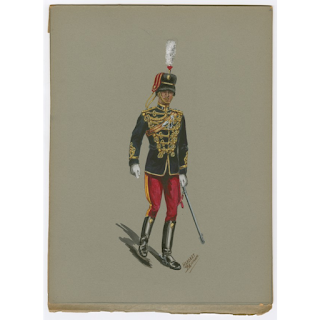After a short break, we are back with news from the Gods of War 6mm front!
Pod chwilowej przerwie powracamy do nowości z frontu Bogów wojny w 6mm!
 |
| The Thirteenth Hussars on manoeuvres under Lieut. Colonel S.G. Jenyns, C.B. , Orlando Norie |
 |
| 11th Prince Albert's Own, Herbert Benham |
Huzarzy brytyjscy
Huzarzy to jeden z najsłynniejszych rodzajów kawalerii. Ubrani w niesłychanie zdobne stroje, uważani za szaleńczo odważnych, stanowili nieodłączny element pól bitew w XVIII i XIX wieku. Lata 50te, 60te i 70te XIX wieku były okresem niezwykle szybkich przemian w technice wojskowej. Nowe bronie wymuszały zmiany w taktyce, chociaż często przychodziło to bardzo opornie. Nie inaczej było w bardzo konserwatywnej armii brytyjskiej, gdzie wciąż żywy był duch Wellingtona. Brytyjska kawaleria lat 50tych i 60tych XIX wieku poświęcała bardzo mało czasu na treningi strzeleckie, czy walkę w spieszeniu, zakładając, że poza zadaniami zwiadowczymi, podstawową rolą kawalerii na polu bitwy będzie uderzenie w formacji na broń białą. Dopiero pod koniec lat 60tych XIX wieku zaczęło się to zmieniać. Kawaleria, która walczyła z Mahdystami, czy Zulusami była już zupełnie inna niż ta z bitwy pod Bałakławą.
Nasze figurki przedstawiają brytyjskich huzarów z przełomu lat 50tych i 60tych XIX wieku. Ubrani w szamerowane dolmany, czapy futrzane z kitami, byli podobni bardziej do kawalerii z wojen napoleońskich, niż tej z wojny secesyjnej. W służbie w koloniach, z uwagi na gorący klimat, stosowano już wygodniejsze mundury, ale w Brytanii i zapewne w Kanadzie dalej w użyciu były tradycyjne stroje.
 |
| 13th Hussars Aldershot 1872-3, Geoffrey H. Brennan, Robert Ebsworth |
Rzeźby przedstawione na obrazkach to dalej „work in progress”, brakuje im już tylko kilku drobnych elementów (np. kity pod szyją konia).
W zestawie znajdzie się 5 póz huzarów. Oficer, chorąży, trębacz i dwóch szeregowców. Szeregowcy i oficer mają wyciągnięte szable. Na uzbrojeniu szeregowców znajdują się również karabinki.
W grze kawaleria brytyjska będzie miała sporą siłę uderzeniową, w walce na broń białą na pewno wypadnie lepiej niż jazda Unii, czy Konfederacji. Jednakże z uwagi na szkolenie i teorie wykorzystania taktycznego nie będzie mogła się spieszać! To oznacza, że czekają ją bohaterskie szarże na broń białą. Kto powiedział, że nie można powtórzyć Bałakławy? :)
Autorem rzeźb jest Marcin Szymański.
Ryciny za: Brown University Library Prints, Drawings, and Watercolors from the Anne S.K. Brown Military Collection
British hussars
Hussars are one of the most famous types of cavalry. Dressed in incredibly fancy clothing, considered to be madly brave, they were an inseparable element of battlefields in the eighteenth and nineteenth centuries. The 1850s, 1860s and 1870s were a period of unusually rapid changes in military technology. New weapons forced change in tactics, although it often came very reluctantly. It was no different in the very conservative British army, where Wellington's spirit was still alive. The British cavalry of the 1850s and 1860s spent very little time on training of dismounted tactics and rifle fire, assuming that apart from reconnaissance tasks, the basic role of cavalry on the battlefield would be to charge in formation with white weapons. It was not until the late 1860s that it began to change. The cavalry, which fought against the Mahdists or Zulus, was completely different from that of the Balaclava.
Our miniatures depict British hussars from the turn of the 1850s and 1860s. Dressed in braided dolmas, fur caps with crests, were more similar to the cavalry from the Napoleonic Wars than from the Civil War. In service in the colonies, due to the hot climate, more comfortable uniforms were used, but in Britain and probably in Canada, traditional costumes were still in use.
 |
| 13th Hussars on march, Orlando Norie |
The sculptures depicted in the pictures are referred to as "work in progress", they only lack a few small elements (eg crests under the neck of a horse).
5 hussar poses will be included in the set. Officer, ensign, trumpeter and two privates. The privates and officer have their sabers drawn. There are also carabines for the privates.
In the game, the British Cavalry will have a lot of impact, in the melee will surely be better than Union or Confederate cavalry. However, due to the training and theories of tactical use, she will not be able to dismount! This means that heroic charges with white weapons await her. Who said you can not repeat Balaklava? :)
The author of the sculptures is Marcin Szymański.
Figures for: Brown University Library Prints, Drawings, and Watercolors from the Anne S.K. Brown Military Collection
Text & Photo: Torgill







This comment has been removed by a blog administrator.
ReplyDelete